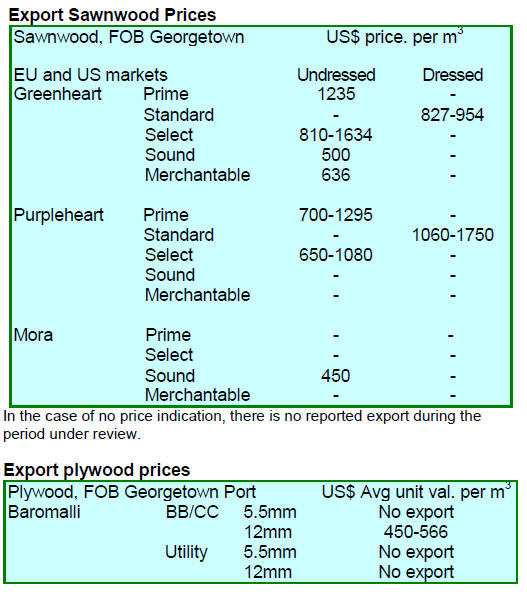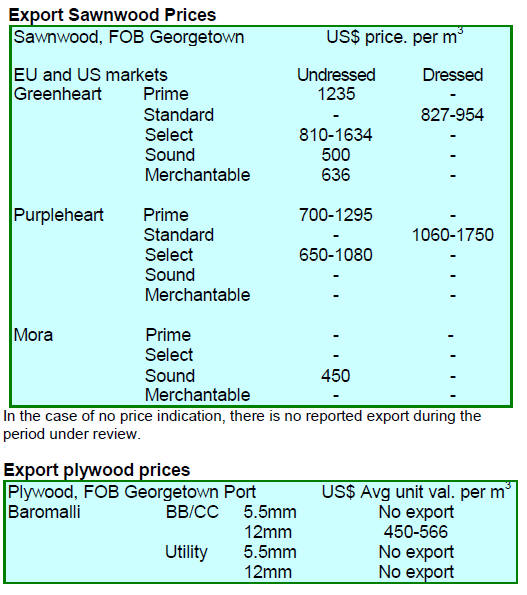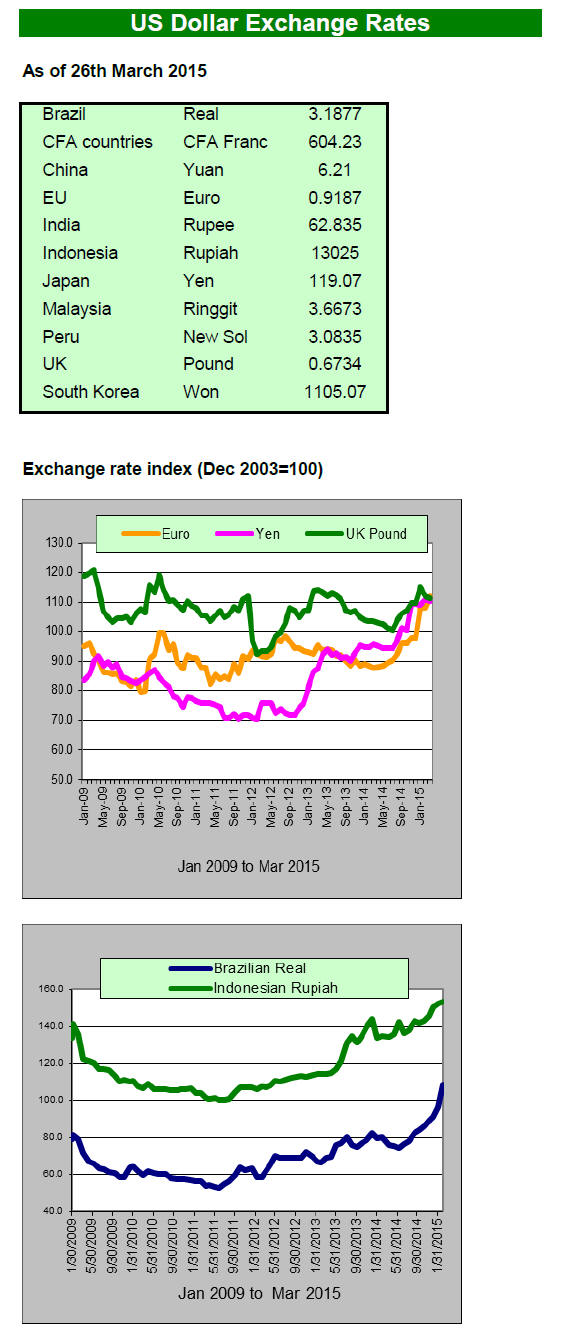2. GHANA
2014 wood product export up 31%
Ghana‟s cumulative wood products exports in 2014
totalled 356,036 cu.m, earning the country a total revenue
of Euro138.22 million. Compared to 2013 exports there
was a 16% increase in the value of exports and a 31%
increase in export earnings in 2014.
The table below shows the product performance for 2013
and 2014.
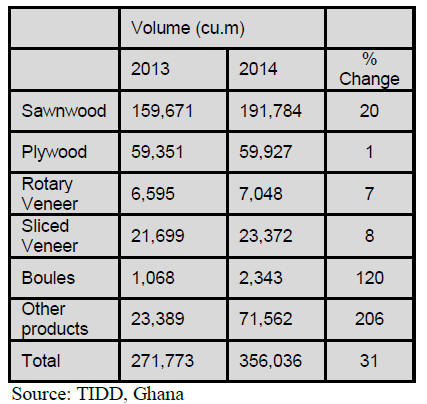
Primary products comprising poles and billets
accounted
for 59,347cu.m or 17% of the total export volume.
Exports of secondary products such as sawnwood, boules,
veneers, blockboard and plywood amounted to 285,086
cu.m with tertiary products, such as mouldings, dowels,
flooring and profile boards, accounting for the remaining
volume.
In 2014 markets in Asia and the Far East accounted for
almost half of Ghana‟s wood product exports compared to
21% in 2013. See graph below:
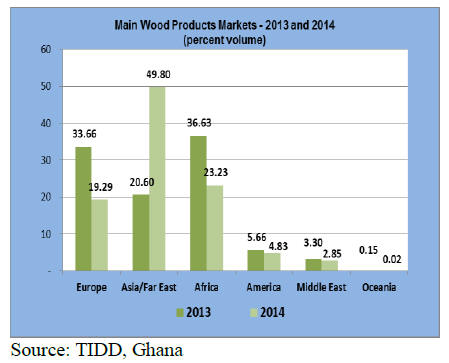
The increase in exports to the Asian/Far Eastern
markets
in 2014 is mainly the result of an expansion of trade in
poles and billets (primarily plantation teak) imported by
India, Bangladesh and China.
Plantation strategy released
The Ghana Forestry Commission recently posted on its
website details of its plantation strategy, „GHANA
FOREST PLANTATION STRATEGY 2015-2040‟
See
http://www.fcghana.org/userfiles/files/Plantation%20Annu
al%20Report/Ghana%20Forest%20Plantation%20Strategy
%202015-%202040.pdf
This strategy sets out how it is proposed the government
and private sector could reforest degraded forest lands by
developing commercial forest plantations of exotic and
indigenous tree species at an annual rate of 20,000 ha over
the next 25 years.
Additionally, the strategy targets the maintenance and
rehabilitation of an estimated 235,000 ha of existing forest
plantations as well as enrichment planting of 100,000 ha
of under-stocked forest reserves with high value
indigenous timber species over the same period.
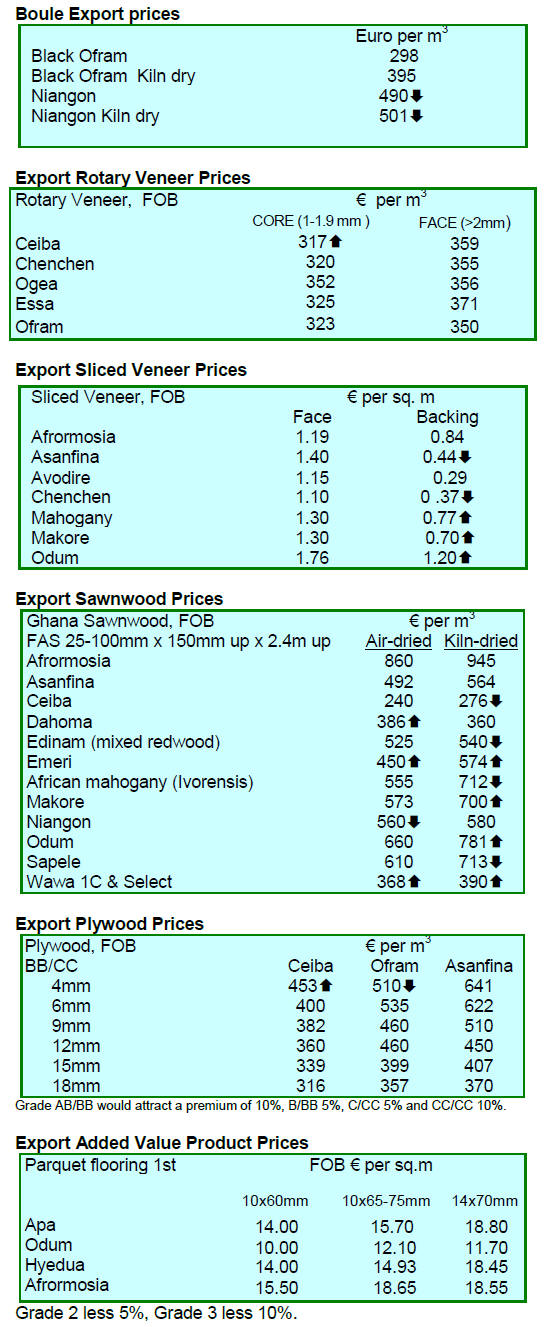
3. MALAYSIA
Malaysia Japan Trade
Trade between Malaysia and Japan amounted to
RM137.45bil (approx.US$42bil) in 2014, an increase of
1.4% on 2013. Exports totalled RM82.71bil (approx.
US$25.6bil), up 4.4% while imports declined 2.9% to
RM54.75bil (approx. US$16.74bil).
Malaysian Ambassador to Japan, Datuk Ahmad Izlan
Idris, said when speaking to the national news agency
Bernama, that the main exports from Malaysia to Japan
were liquefied natural gas, electronics and chemical-based
products. Malaysia‟s main imports from Japan were
electrical goods, machinery as well as spare parts and
accessories for vehicles. Japan is Malaysia‟s third largest
trading partner after China and Singapore.
Future of industry is in plantation timbers
Sarawak aims to develop an export trade in wood products
manufactured from plantation and the Chief Minister,
Adenan Satem, said ¡°The policy of the state on timber is
very simple. We wish one day to be exporting wood
products made from plantation resources only¡±.
However, he followed up by saying ¡°We still cannot do
that now because there is no volume of planted forests. We
have to be realistic or our mills will shut down and our
industry will collapse if we do it yet.¡±
The Statistics Department of Sabah has released the
January 2015 export data.
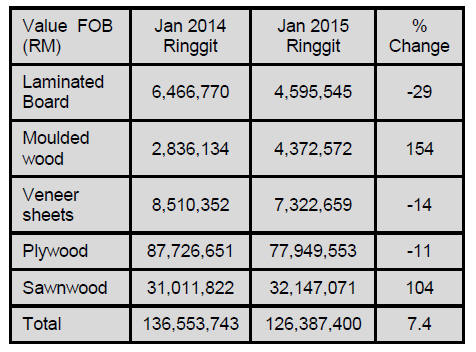
4. INDONESIA
€13.5m for Indonesian forest protection
Antara news reports that Germany has pledged euro13.5
million for a forest and biodiversity conservation
programme in the Palu/Miu watershed and Lore Lindu
National Park in Central Sulawesi.
The state-run news agency says an agreement is due to be
signed by the German Ambassador to Indonesia, Georg
Witschel and by Robert Pakpahan of the Indonesian Risk
Management Directorate.
President of Indonesia opens the furniture fair - IFEX
Indonesia's largest ever furniture trade show, the Indonesia
International Furniture Expo, IFEX 2015, was opened by
the President of Indonesia, Mr. Joko Widodo. In a press
release the organisers noted it was particularly fitting that
the President should open the fair as his background is in
the furniture business.
IFEX is organised by PT Dyandra UBM International, a
joint venture between Dyandra, Indonesia's leading
exhibition organiser and UBM Asia, the largest
commercial organiser of tradeshows in Asia. The
exhibition is hosted by the Indonesia Furniture
Association, AMKRI.
Mr. Ernst K. Remboen, President Director of PT Dyandra
UBM International, commented, "the furniture industry in
Indonesia is enjoying very robust growth on the back of
strong exports and surging domestic demand.
The nation has abundant supplies of sustainable raw
materials such as wood, rattan, bamboo and natural
textiles, as well as a highly skilled labour force and
extensive manufacturing capacity.¡±
For more see: www.prnewswire.com/newsreleases/
president-jokowi-opens-indonesias-flagshipfurniture-
exhibition-ifex-300050148.html
TLAS deadline ¨C 31 December
The Director General of Forestry Enterprises in the
Ministry of Environment and Forestry, Bambang
Hendroyono, has said full implementation of the country‟s
timber legality assurance scheme (TLAS) must be
completed by 31 December this year.
Indonesian timber exports have increased since the
introduction of the national TLAS and while some of the
growth in exports is due to improving international
demand proof of legality provided through the TLAS
scheme has given importers the greater confidence to
purchase Indonesian wood products.
ADB signals bright prospects for manufacturing
Indonesia‟s economy is expected to accelerate over the
next 2 years says the Asian Development Bank (ADB) but
the government has been urged to push ahead with
structural reforms building on the reduction of subsidies.
In its annual „Asian Development Outlook 2015‟ the ADB
projects Indonesia‟s GDP growth to reach 5.5% this year,
and 6.0% in 2016.
One of the main pillars of growth will be reviving
manufacturing now that the commodity boom has faded.
Manufacturing in Indonesia, says the ADB, has been
constrained by inefficient and strained infrastructure, the
appreciation of the currency, regulatory uncertainties and
logistics costs.
For its part the Indonesian government plans to
invest in
port and transportation infrastructure and to improve the
investment climate.
See: www.adb.org/news/indonesian-growth-recoversustained-
momentum-reform
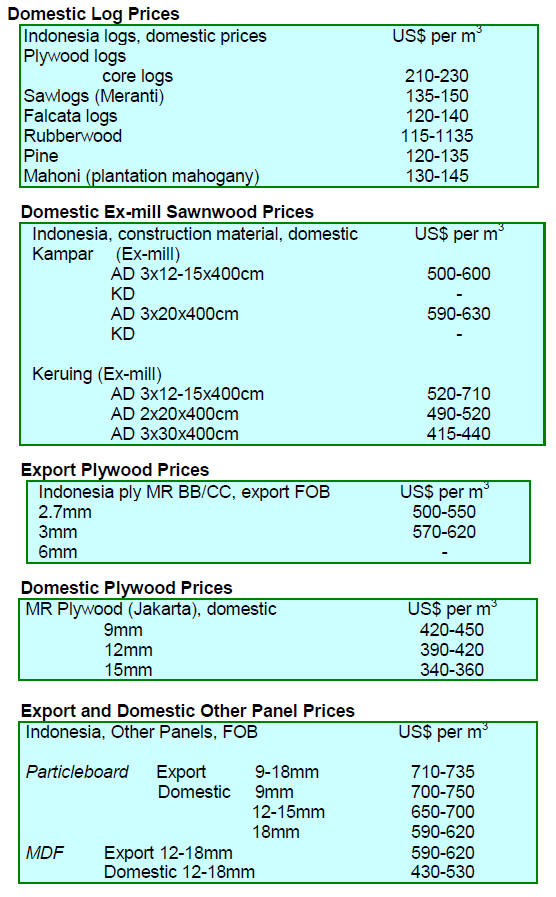
5. MYANMAR
First national export strategy launched
With support from the International Trade Center (ITC)
Myanmar has launched its first National Export Strategy
(NES) designed to aid the country‟s development through
export promotion.
See the ITC press release at:
http://www.intracen.org/news/Myanmar-launches-first-
National-Export-Strategy/#sthash.DAh9QYeH.dpuf
The ITC press release says the NES is a five-year roadmap
of the needs and priorities for Myanmar‟s sustainable
development through trade.
Action plans in the NES include interventions to boost the
competitiveness of small and medium-sized enterprises,
longer-term policy and legislative changes all geared at
realising the vision of the strategy, namely sustainable
export-led growth and prosperity for an emerging
Myanmar.
The NES seeks to shift Myanmar‟s trade patterns from a
concentration on a handful of products, mostly
unprocessed natural resources, to production and value
addition in the following priority sectors: beans, pulses
and oilseeds; fisheries; forestry products; textiles and
garments; rice; rubber; and tourism.
For the private sector to fully benefit from this
transformation the NES tackles constraints in the business
environment by addressing access to finance, trade
information and promotion, trade facilitation and logistics.
International Day for Forests observed
The Ministry of Environmental Conservation and Forestry
(MOECAF) observed the International Day of Forests in
Nay Pyi Taw, the capital city of Myanmar. Union
Minister, Win Tun in an address highlighted the theme of
this year‟s „International Day of Forests‟ as „forests and
climate change‟.
He mentioned that the rate of deforestation in Myanmar
would have drop sharply to achieve the target of 0%
deforestation by 2030.
Myanmar NewYear
The long Myanmar New Year holiday beginning with
Thingyan will run 11-20 April and the majority of
businesses will be closed during that period.
March tender results
The following timber was sold by Myanma Timber
Enterprise (MTE) by tender on 13 and 16 March. Log
prices are expressed in hoppus tons and conversions (sawn
and hewn teak prices are shown in cubic tons). Average
US dollar prices are shown below.
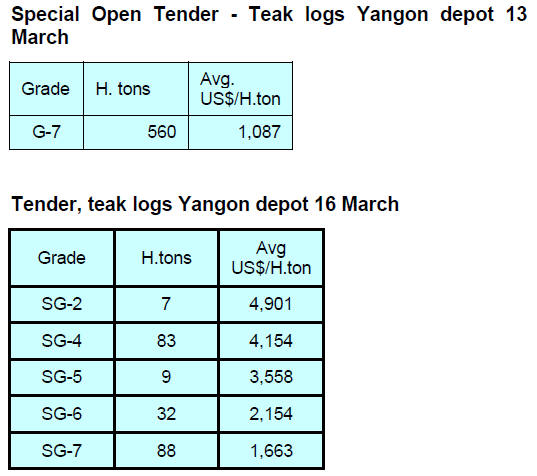
This month the average prices for teak logs are
higher than
the previous month and the difference in prices for SG-7
lots in the Open Tender No.15 and Open Tender No.12
was significant. This may be because the grading was very
flawed. SG-7 logs are not expected to yield a high outturn
percentage compared to the outturn from SG-4 and SG-2
logs.
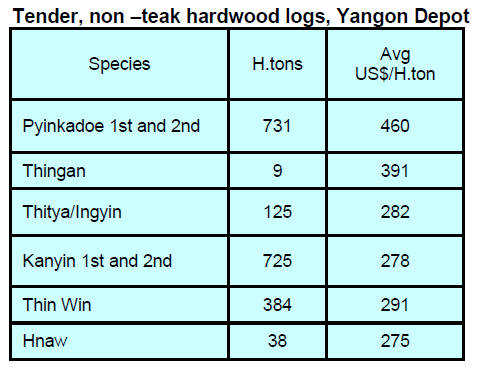
6.
INDIA
National forest certification system
debated
A process to develop a national forest certification system
was launched during the recent ¡°International Conference
on Forest Certification ¨C Positioning India¡±.
This conference was co-hosted by the Indian Network for
Certification and Conservation of Forests (NCCF) and
PEFC International and brought together stakeholders to
discuss the status of forests in India and to learn from
international experts about the benefits of functioning
certification systems.
The Chairman of NCCF said ¡°With forestry in India being
at a critical crossroad, the decision to develop our own
national forest certification system will be an important
driver to promote the sustainable management of our
forest resources.
While India is among the world‟s most forested countries,
we also have a growing demand for wood products and
unsustainable use of forests, for example for wood fuel, is
a significant challenge.¡±
For more see:www.pefc.org/news-a-media/general-sfmnews/
1822-india-launches-process-to-develop-forestcertification-
system
Increasing forest cover through village plantings
The government has merged the National Mission for a
Green India with the Mahatma Gandhi National Rural
Employment Guarantee Scheme (MGNREGA) to increase
and improve the country's forest cover.
To synergise the efforts of both agencies to address
climate change concerns guidelines have been developed
which define the approach to be adopted to strengthen
implementation of the plan to improve the livelihood for
about three million village households.
Under the plan all village common land, community lands,
wastelands, shifting cultivation areas, wetlands and private
agricultural lands will be eligible for assistance when
afforestation is undertaken. The State Forest Development
Agencies (SFDA) will provide technical advice on tree
species and will provide seedlings.
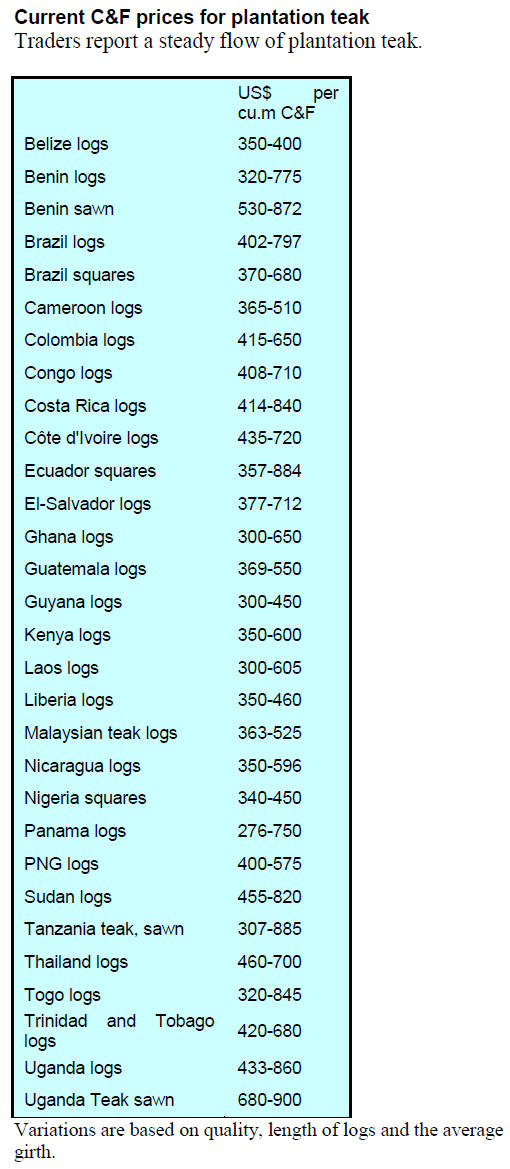
In addition to the plantation teak arrivals,
natural forest
teak logs from Vietnam continue to arrive and prices are
unchanged at US$1349 per cubic metre.
Cambodia and Laos new suppliers of logs and
veneer
Because poplar faced plywood has gained acceptance in
the Indian market and because veneer imports from
Myanmar are rising imports from Vietnam have fallen.
Analysts report that Cambodia and Laos are emerging as
potential suppliers of veneers as well as hardwood logs
and Indian companies are showing interest in establishing
veneer and plywood mills in these two countries.
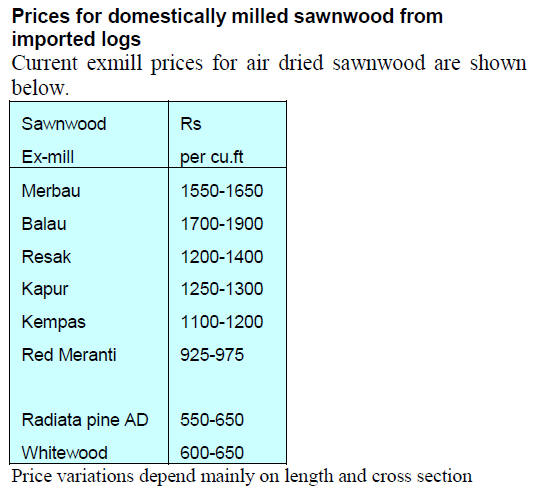
Indian companies in Myanmar to export sawn teak
The volume of teak sawnwood imports into India from
Myanmar is increasing and Indian companies operating in
Myanmar are planning to expand international exports of
sawn teak.
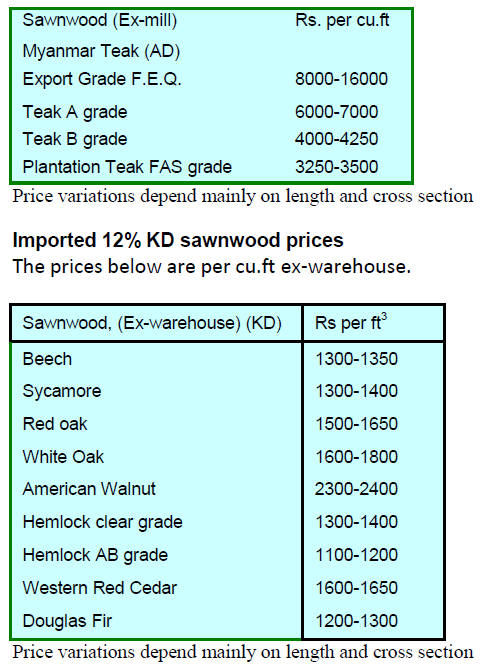
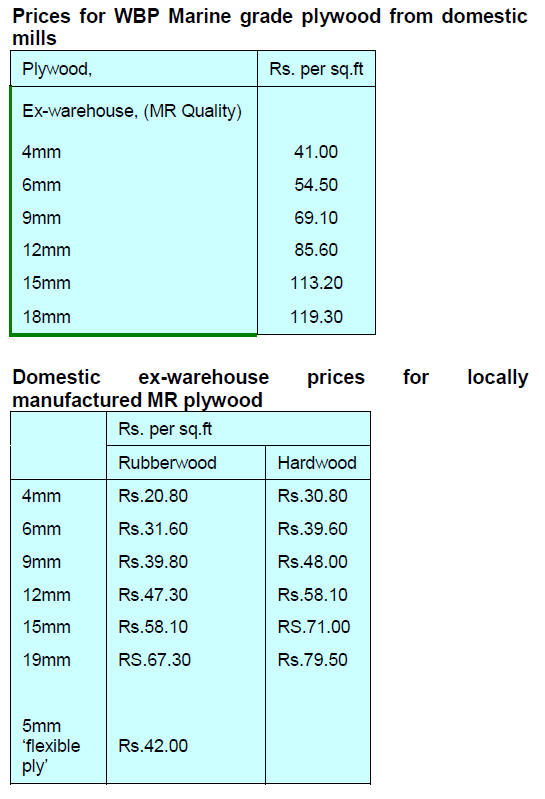
¡¡
7.
BRAZIL
Can ISO 19.228 become the forest
certification
standard
In late March the Associação Brasileira de Normas
T¨¦cnicas (ABNT) organized a meeting to discuss a
proposed standard for forest certification (ISO 19.228), a
standard that will create a global certification norm to help
eliminate the trade in illegal timber. ABNT was created in
1940 as a non-profit organization engaged in the
preparation of Brazilian national standards.
The meeting, held in Salvador (Bahia state) discussed
issues such as forest management, legality and timber
origin, the inclusion of small producers in the standard and
timber tracking mechanisms. The main theme of the
gathering focused on the opportunity the standard could
offer to producers in securing access to the most
demanding markets.
The March meeting was the third such gathering. Previous
meetings took place in 2014 in Berlin and Paris. Further
meetings are scheduled to take place in London and in
Stockholm (2016).
For more see:
www.ecodesenvolvimento.org/posts/2015/marco/bahiasedia-
encontro-mundial-sobre-certificacaode/
popup_impressao
Combating deforestation in the Amazon
The Brazilian Ministry of Justice and the Brazilian
Development Bank (BNDES) recently concluded an
agreement to finance efforts to combat illegal
deforestation in the Amazon. The fund will ensure the
permanent presence of about 200 National Public Security
Force officers in the Amazon to combat environmental
crimes.
The Ministry of Environment has praised the work of the
National Public Security Force in addressing forest crime.
Prospects for economy darken
Brazil‟s Consumer Price Index (IPCA), was 1.22% in
February 2015, recording a slight drop compared to the
1.24% increase in January 2015 which was the highest rate
since 2003, when the inflation rate topped 1.57%.
The Monetary Policy Committee (COPOM) of the
Brazilian Central Bank (BCB) increased the prime interest
rate (Selic) from 12.25% to 12.75% at its 4 March
meeting. At 12.75%, the interest rate is equivalent to the
level observed in January 2009.
In its latest assessment of the economy the Brazilian
Central Bank is sounding warnings of continued
weakness.
GDP estimates for 2014 have been revised down from the
forecast of 0.2% to a 0.1% contraction. For 2015 the Bank
expects a further decline in GDP of 0.5%. If the Bank is
correct this would be the first time in decades Brazil‟s
economy has shrunk in two consecutive years.
Export performance round-up
In February 2015, the total value of Brazilian exports of
wood-based products (except pulp and paper) fell 3.6%
compared to February 2014, from US$ 221.6 million to
US$ 213.6 million.
The value of pine sawnwood exports fell 3.4% in February
compared to February 2014, from US$17.4 million to
US$16.8 million. In terms of volume, exports fell 5.2%,
from 75,300 cu.m to 71,400 cu.m over the same period.
The volume of tropical sawnwood exports also declined in
February dropping 13.6% from 28,000 cu.m in February
2014 to 24,200 cu.m in February 2015. In terms of value,
tropical sawnwood exports decreased 16.0% from
US$16.3 million to US$13.7 million, over the same
period.
On a brighter note both pine and tropical plywood exports
rose in February. Pine plywood exports jumped 5.3% in
value in February 2015 compared to levels in February
2014, from US$34.1 million to US$35.9 million (92,300
cu.m to 95,600 cu.m).
Tropical plywood exports more than doubled from 3,700
cu.m in February 2014 to 7,600 cu.m in February 2015
(US$ 2.3 million in February 2014 to US$ 4.0 million in
February 2015).
However, wooden furniture exports remain weak and
February exports were down over 12% from US$ 37.2
million in February 2014 to US$ 32.6 million in February
this year.
Improving US demand a lifeline to the Brazilian timber
industry
Slowing economic activity in Brazil is affecting the timber
sector particularly as building and construction projects
have been scaled back and consumers are less inclined to
spend on household improvements and furniture. Now
Brazilian companies are focusing on foreign markets
especially the United States as demand is recovering.
It is expected that wood product exports to the US will
increase by around 20-25% in 2015. In particular exporters
of sawnwood anticipate much higher export sales to the
US this year.
In 2005, pine sawnwood exports to the US totalled
US$304 million but five years later had declined to just
US$ 154 million. In 2007 and 2008, the global economic
crisis weakened demand and the appreciation of the
Brazilian currency affected competitiveness and during
this difficult period the Brazilian timber industry had to
rely on domestic demand.
The recent depreciation of the US dollar has helped
improve the competitiveness of Brazilian products but has
also increased production costs. In September 2014, the
exchange rate was R$2.20 per US dollar but in March this
year the rate touched R$ 3.00 to the dollar. In addition to
the impact on production costs overseas buyers are now
pushing for lower prices as exports are priced in dollars
and buyers wish to take advantage of the weakening
Brazilian currency.
MOVELPAR claims success in promoting Brazilian
furniture exports
MOVELPAR, the Furniture Fair held in Arapongas
municipality (Paran¨¢ State) between 9 and 13 March this
year, hosted prospective importers from 10 countries and
reports indicate that business deals worth over US$10
million were concluded .
Some 24 furniture manufacturers which are members of
the APEX Furniture Program of APEX (Brazilian Agency
for Export and Investment Promotion) and ABIMÓVEL
(Brazilian Furniture Industry Association), participated in
the International Buyer project.
Furniture importers from Mexico, Colombia, Ecuador,
Mozambique, France, Honduras, Panama, Peru, South
Africa, Democratic Republic of the Congo, Bolivia, Chile,
the United States, Italy, Moldova, Namibia, Nigeria,
Pakistan, Paraguay, Puerto Rico, Turkey and Uruguay
attended the fair.
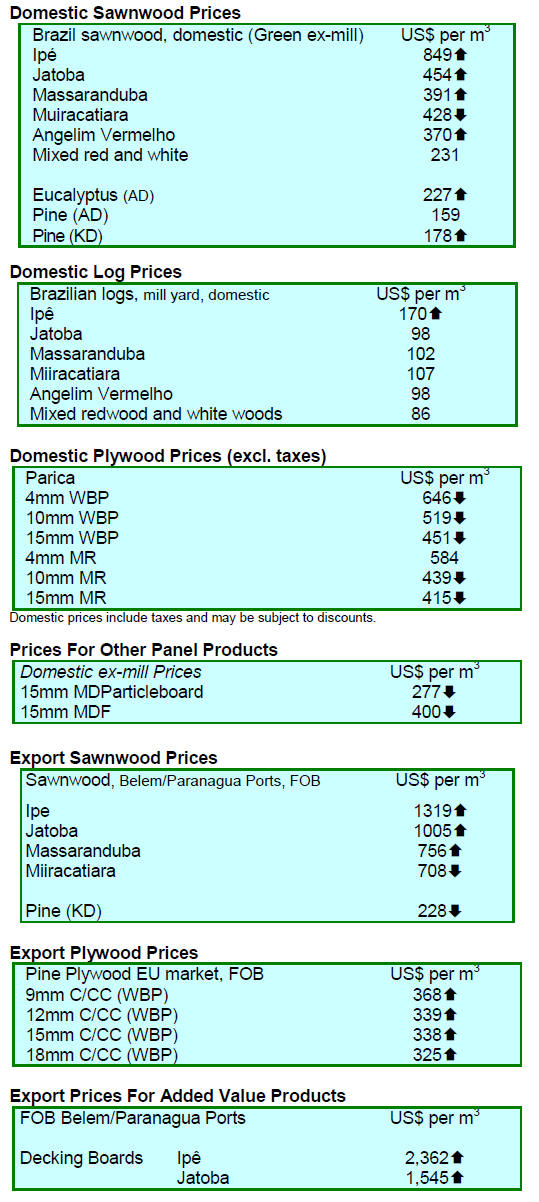
8. PERU
Regular audits to monitoring concessions
The new Five-Year Audit requirement for forest
concession holders which is to be introduced will allow for
better monitoring said Max Salazar, the Secretary General
of the Agency for Supervision of Forest Resources and
Wildlife (OSINFOR).
The new audit procedures were developed after
informational workshops with stakeholders in Loreto,
Ucayali, Madre de Dios and San Mart¨ªn.
Can forestry generate US$ 3 billion annually?
Agriculture Minister, Juan Manuel Benites said forestry in
Peru could contribute as much as US$3 billion to the
economy and make a huge contribution to GDP but noted
the forestry sector is one of the most poorly developed
sectors and ways must be found to encourage investment
in the sector.
Forest regulation to take effect in April
With the agreement of seven organisations representing 52
indigenous groups in the country the rules and regulations
in the new Forestry and Wildlife Law have been officially
adopted.
The regulations provide for simplification of procedures in
the granting of forest concessions and aim to create
conditions for protection to those investing over the long
term in forestry development.
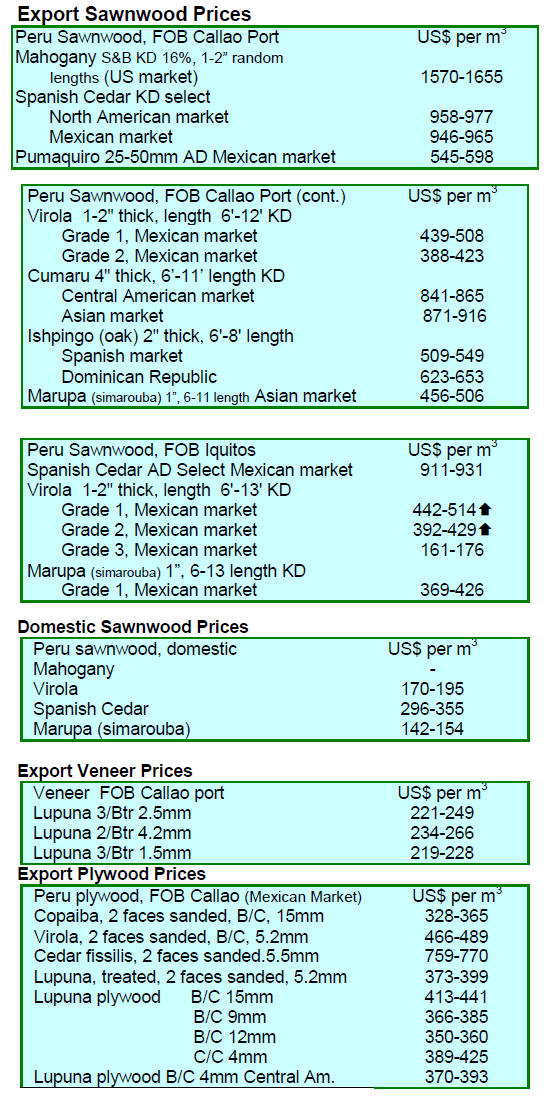
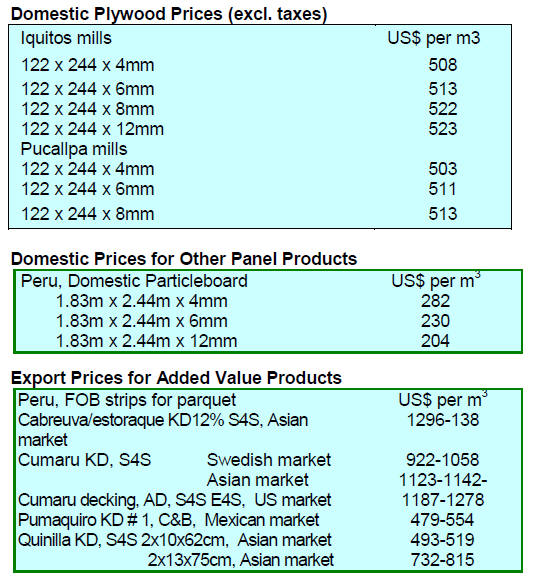
9.
GUYANA
Value-Added processing on the rise
The Forest Products Development and Marketing Council
Guyana (FPDMC) has surveyed many of the
manufacturers and wood working companies in Guyana to
gauge the trends in downstream processing.
Log exports from Guyana comprise around 35% of the
harvest, the balance being processed locally. In addition to
the production of sawnwood added value products such as
plywood, doors, mouldings, flooring, wall panels, outdoor
and indoor furniture are manufactured. Over the years
there has been an increase in the production of high value
products by a number of companies in Guyana.
Currently there are over 200 sawmills across the country
producing mainly building material. New companies are
entering the sector and established enterprises are striving
to widen their product base with new designs and
innovations.
Some of the key export destinations for value added
products from Guyana include the Caribbean, Europe,
North and South America as well as the Middle East. The
timber industry in Guyana currently contributes around
4% to GDP.
Export prices
There were no exports of greenheart logs in the period
reported.
